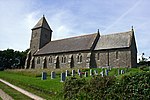RAF Bolt Head
Royal Air Force Bolt Head or more simply RAF Bolt Head is a former Royal Air Force satellite airfield 1 mile (1.6 km) south west of Salcombe on the south Devon coast, England from 1941 to 1945. During the Second World War it was used as a satellite for RAF Exeter. There were two runways, of 3,680 ft at 45° and 4,200 ft at 120°.The Ground Control Interceptor Station (GCI) RAF Hope Cove was established on the northeast side of the field in 1941 to direct fighter operations in the English Channel. Unlike the airfield, Hope Cove remained in use into the 1990s. Today the World War II buildings are almost all gone but a memorial to the airfield's war-time history exists in the centre of the site, two notable post-war buildings survive including a large R6 Rotor bunker (used until 1994 as a Regional Seat of Government) and a grass airstrip is still used occasionally by light aircraft. The landowners also hosted an air display there in 2009 which saw a Hurricane and Spitfire visit the airfield for the first time since the war.
Excerpt from the Wikipedia article RAF Bolt Head (License: CC BY-SA 3.0, Authors).RAF Bolt Head
South Hams Malborough
Geographical coordinates (GPS) Address Nearby Places Show on map
Geographical coordinates (GPS)
| Latitude | Longitude |
|---|---|
| N 50.223333333333 ° | E -3.8058333333333 ° |
Address
TQ7 3DS South Hams, Malborough
England, United Kingdom
Open on Google Maps









